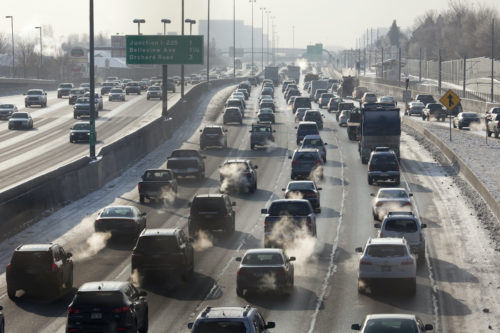
If You Build It, the Cars (and the Pollution) Will Come
Estimating Impacts of Road Expansion in Colorado
Colorado plans to expand highways by almost 200 new lane-miles over the next decade. RMI analysis suggests this could increase driving and pollution at the scale of adding 70,000 more cars to Colorado roads every year, running counter to Colorado’s robust climate and transportation policy goals.
Road Expansion Fails to Deliver Promised Benefits
The physical footprint of the past 40 years of road and highway development is hard to miss. Since 1980, total lane-miles in urban and suburban areas, where 70 percent of traffic occurs, have doubled. Despite a decades-old theoretical understanding that road expansion does not ease congestion, new projects continue to be justified on these grounds. Road expansion projects have failed to deliver the promised benefits, while evidence continues to mount that they exacerbate traffic and associated pollution. As US leaders consider a dramatic infusion of public investment in infrastructure, now is the time to rethink how we develop our road infrastructure and our solutions to problems like congestion.
A rich body of research shows that the congestion reductions associated with road expansions are short-lived, generally fully evaporating after 5 to 10 years of use. On balance, the congestion benefits of road expansions ultimately cancel out because travel demand increases proportional to the new capacity—drivers respond to the newly open road space by engaging in more frequent and longer trips. However, transportation planning processes typically underestimate this increase by as much as an order of magnitude, meaning that decision makers systematically overstate the benefits of road expansions, continuing a cycle of growth.
Road expansion projects achieve only fleeting benefits at a time when decarbonization of transportation could not be more urgent. For the United States to be on track toward a safe climate future, RMI analysis (to be published later this month) calls for reducing passenger vehicle travel 20 percent per capita by 2030, in addition to ambitious adoption of electric vehicles.
Instead, road expansion projects move us in the wrong direction, generating more traffic that increases climate pollution, worsens local air quality, and leads to more road crashes. Vulnerable and frontline communities bear a disproportionate burden from these impacts, including health effects from hazardous air pollutants and pedestrian deaths.
RMI analysis of planned transportation projects in Colorado highlights the risk of continuing to move in the wrong direction at the state level. In Colorado, a portfolio of planned and proposed expansions of interstates and other major roads would lead to hundreds of millions of additional annual vehicle miles traveled (VMT) on Colorado roads, posing a hurdle to achieving the state’s goal of reducing VMT 10 percent by 2030 while spending potentially billions of dollars in the process.
About the Calculator:
RMI has developed and calibrated an induced travel calculator to evaluate the impacts of road widenings in Colorado, including their effect on state-wide vehicle miles traveled (VMT) and their emissions impacts. The calculator builds on analysis and methodology first published by Jamey Volker and Susan Handy at the University of California—Davis to calculate the induced travel impacts of lane-mile additions in California metros and counties. It was also recently extended by Joe Cortright to Portland, Oregon.
The calculator enables users to estimate long-run induced VMT from capacity expansions of large roadways (interstates, state highways, and arterials) in Colorado urbanized areas based on existing lane-mileage and VMT data. Drawing from the body of literature estimating the relationship between VMT and lane-mileage increases on these roads, it applies a ratio of 1.0—meaning a 1 percent increase in lane-mileage yields a 1 percent increase in VMT. The calculator outputs a reasonable estimate for VMT induced at the appropriate order of magnitude for a given area.
The calculator is not intended as a substitute for more granular traffic modeling or simulations—but rather as a tool that can effectively translate well-established induced travel demand literature to an informed understanding of the impacts of road expansions.
The calculator tool is available for public use. Please reach out to our team if you are interested in underlying calculations and primary data.
A Rule of Thumb for Estimating Impacts of Colorado Road Expansions
Using this tool to evaluate impacts across areas in Colorado, we estimate traffic will increase by a range of 2 to 8 million VMT per year for every new highway lane-mile added in Colorado’s urbanized areas. More densely populated areas with busier roads tend to fall on the upper end of the range. Taking the midpoint to conservatively represent a statewide impact, each Colorado lane-mile added translates to about 400 more cars and SUVs on roads every year and generates annual carbon pollution equal to about 200,000 additional gallons of gasoline.
Estimating the Impact of Colorado’s Planned Projects
In partnership with NRDC, SWEEP, and CoPIRG we reviewed a selection of high-profile planned and in-progress road expansion projects in Colorado, estimating that 176 new highway lane-miles could be added by 2030. As a result, we estimate that induced demand could ultimately lead to 1 to 1.5 billion additional VMT on Colorado roads per year. This would represent a roughly 2 percent increase over current Colorado VMT equivalent to about 70,000 more cars, SUVs, and light trucks on roads annually, incremental to current trends. Projects under construction like Central 70 account for roughly 0.5 to 1 billion of the induced VMT, meaning there is a significant window of opportunity to rethink the current approach for the projects remaining in the planning phase.
As it stands, this project portfolio would negatively impact Colorado’s greenhouse gas reduction goals. RMI analysis suggests the portfolio would increase direct and upstream greenhouse gas emissions by 8 to 15 million tons of CO2-equivalent cumulatively through 2050. The analyzed range spans the level of ambition for other measures to reduce pollution from on-road vehicles: the lower estimate assumes an aggressive climate ambition scenario developed by Energy Innovation using the Colorado Energy Policy Simulator, while the higher estimate assumes current trends and policy.
The upstream emissions include petroleum refining, extraction, and vehicle manufacturing, much of which may occur out of state—but the location of emissions does not matter to the climate. Because of these upstream emissions and the time required to replace the vehicle fleet with cleaner alternatives, vehicle electrification is necessary but not sufficient for a safe climate future: we must reverse the cycle of car-dependence as well.
An Expensive Step Backward
As US leaders at the state and federal levels plan for the future of US transportation systems, they must prioritize investments that rapidly drive down emissions and provide enduring benefits. The Colorado Induced Travel Calculator provides an instructive example of the consequences and costs of relying on road expansions as a solution to congestion. Total direct costs associated with the projects exceed $3 billion: meaning Colorado would be paying billions of dollars to increase rather than decrease pollution. Even more money could be spent if Colorado appropriated additional funding for the entire scope of highway expansions in the pipeline.
To decrease pollution, forward-looking transportation investments should be aimed at measures that would actually reduce traffic and boost accessibility. This means making investments that help create more inclusive, compact, mixed-use communities; that support walking, biking, and micro-mobility; and that expand and improve public transit. Those investments can help ease congestion while keeping Colorado’s (and the nation’s) skies clean.

